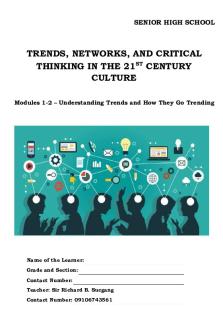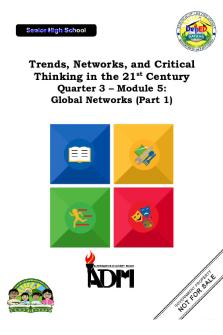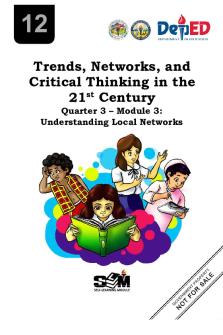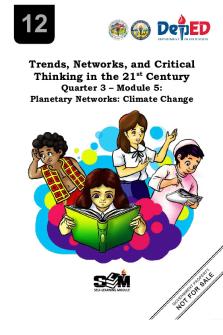TNCT Module 1-2 - TRENDS, NETWORKS, AND CRITICAL THINKING PDF

| Title | TNCT Module 1-2 - TRENDS, NETWORKS, AND CRITICAL THINKING |
|---|---|
| Course | Bachelor of Secondary Education |
| Institution | Mindanao State University |
| Pages | 17 |
| File Size | 672.6 KB |
| File Type | |
| Total Downloads | 34 |
| Total Views | 144 |
Summary
TRENDS, NETWORKS, AND CRITICAL THINKING...
Description
SENIOR HIGH SCHOOL
TRENDS, NETWORKS, AND CRITICAL THINKING IN THE 21ST CENTURY CULTURE Modules 1-2 – Understanding Trends and How They Go Trending
Name of the Learner: Grade and Section: Contact Number: Teacher: Sir Richard B. Sucgang Contact Number: 09106743561
CONTENT STANDARDS The learner understands the emergence of trends and patterns. PERFORMANCE STANDARDS The learner will be able to derive an idea from instances and present this idea through a 100-word essay, artwork, and other graphic representations. KEEP IN MIND To learn and benefit from this module, follow the following steps: 1. Read the module title and the module introduction to get an idea of what the module covers. Specifically, read the first two sections of this module carefully. The first section tells you what this module is all about while the second section tells you of what you are expected to learn. 2. Never move on to the next page unless you have done what you are expected to do in the previous page. Before you start each lesson, read first the INSTRUCTIONS. 3. Work on the activities. Take note of the skills that each activity is helping you to develop. 4. Take the Post-Test after you are done with all the lessons and activities in the module. 5. Meet with your teacher. Ask him/her about any difficulty or confusion you have encountered in this module. 6. Finally, prepare and gather all your outputs and submit them to your teacher. 7. Please write all your answers of the tests, activities, exercises, and others IN YOUR MODULE. Use a separate paper IF NECESSARY.
LEARNING COMPETENCIES The learners will be able to: 1. Differentiate a trend from a fad Weeks 1-2 (HUMSS_MCT12-Ia-b-3); 2. Explain the process on how to spot a trend (HUMSS_MCT12-Ia-b-2); 3. Point out the elements that make up a trend (HUMSS_MCT12-Ia-b-4); 4. Describe the different characteristics of a trend (HUMSS_MCT12-Ia-b-5); 5. Identify parts of a whole (HUMSS_MCT12-Ia-b-6); 6. Identify and explain an emerging pattern (HUMSS_MCT12-Ia-b-7); 7. Identify causes and consequences (HUMSS_MCT12-Ia-b-8).
1
PRETEST Directions: Choose the letter of the best answer. Then, write your answer in the space provided before the number. 1. Which of the following refers to a movement or behavior geared towards a certain direction which is bound to change, and can be positive or negative? A. fad
B. forces
C. pattern
D. trend
2. The following terms are the factors that shape a trend EXCEPT: A. cultural forces
C. human needs
B. globalization
D. social media
3. Which of the following refers to a concept which make people highly interested in for a relatively short period of time? A. fad
B. forces
C. infatuation
D. trend
4. The following terms are considered as Fad EXCEPT: A. barbie Doll
C. pet rock
B. Ipod
D. social networking sites
5. Because of this factor, trends develop through global advertising platforms of transnational corporations shown on traditional media channels and internet. Which of the following causes develops the trend through global advertising platforms of transnational corporations publicized on traditional media channels and internet? A. digital connectivity
C. human needs
B. globalization
D. social media
ACTIVITY 1. Directions: Analyze the following pictures. Read the cue words from the ideas beside the pictures. Find the answer from the jumbled letters below in each item. It is used on social media to identify specific topics
H Answer:
A
G
S
A
T
S
H
2
Means of mass communication
M
A
D
E
I
Answer:
A set of moral principles
E
H
C
T
S
I
Answer:
Data in the form of digits, images, and broadcasting
T
A
G
I
L
D
I
Answer:
Use one’s mind actively to form ideas
K
N
I
H
T
Answer:
A group or system of interconnected people or things
T Answer:
E
N
K
O
W
R
3
DISCUSSION LESSON 1: EXAMINING TRENDS AND FADS Fad It is seemingly drastic swings in mass behavior without obvious external stimuli. Fads are something that people are highly interested in for a relatively short period of time. It can be characterized as unpredictable, short-lived and without social, economic, and political significance (Bikhcandani, 1992). Karl and Sharpio (1985) described it according to the theory of network externalities, where the utility of a product increases when more people use it. Life cycles of a regular product consists of four stages. • Introduction: The product is introduced to the market; sales are still low and market share is still insignificant. • Growth Stage: The product is steadily rise and a significant market share is achieved. • Maturity Stage: The producers aim to keep the market share through innovations. • Decline: The market may dwindle due to competition or lack of innovation. A fad is often used interchangeably with the word trend. Although a fad is short-lived, what is important to know is that fads can help predict trends. Trends It is a pattern of gradual change in a condition, output or process, or an average or general tendency of a series of data points to move in a certain direction over time, represented by a line or a curve on a graph. It is a new item or a practice that stabilizes and transforms into a habit, a lifestyle, or an enduring product. Some trends seek to innovate lifestyles and find practical ways to solve social issues and improve our well-being. It could be a response to the problems that have confronted groups or societies. It also reveals the shape of the future. A significant social trend is best understood as a series of related events that emanate from a range of causes, manifests a continuity over a a period, and rebounds to significant social, cultural, economic and political changes. Example of trends are rising of OFWs, changing roles of women, changing model of mobile phones, religious fundamentalism as well. Trends and Fads are sometimes used interchangeably. They are both important for organizations and people to keep updated with the changing environment. However, as a member of society, it is important for us to
4
determine the difference between trends and fads using six elements to deepen our understanding of survival and adaptability.
Emergence of Trends How do we recognize that a trend is starting to emerge? The capacity to identify emerging trends is rooted in our capacity to recognize patterns. Our encounter with patterns was facilitated by experience and processed by the mind through abstraction and generalization. According to Philosopher John Locke, there are no innate ideas. All of the ideas that we have are derived from experience and that every complex idea we have in our minds can be traced back to a simple idea. It means that experience is comprised of sensation and reflection. Locke points out that all active mental process such as analyzing, criticizing, evaluating, and judging form part of the reflection of experience. According to Duin and Pekalska (2007), pattern recognition is characterized by three stages, namely. representation, generalization and evaluation. Adaptation, which serves as an intermediary stage is also involved in the process.
5
Our ability to recognize patterns enables us to see and analyze to identify emerging trends. There are internal factors that influence such emergence. These are human needs, historical forces, globalization and digital cone activity, and social media. Factors Shaping Trends Understanding factors that shape trends can provide us insights into how to predict trends, how they are developing, and how they are sustained. The following terms are just some of the factors that shape a trend: • Human Needs Humankind will instinctively tend to its needs. Our desire to build a better world or improve the quality of life compels us to discover, invent and explore new technologies, products, services, forms of knowledge and skills. In meeting our needs, we enhance our intelligence, creativity, and social skills that in turn, increase our chances for survival. • Historical Forces Humankind creates responses in social issues. The response varies how the government impose its power while the citizenry can act on its own. The role of the government is to formulate policies to response societal needs, but when polices are enforced, behaviors change and become trends that are practiced by citizenry. • Globalization The global exchange of goods and services increased the interaction between states and societies. The globalizing world integrates information through global advertising using technologies. Thus, trends and innovations are also carried on a global scale, ensuring the resilience of the products. • Digital Connectivity and Social Media Social Media continue to expand and grow. For example, Facebook has grown into most popular social networking site, catering businesses and entrepreneurial initiatives in the Philippines. Products gain mileage because of the advertising using this platform. Social media’s use of trending is not exactly how trends are defined in this lesson. For example, twitter declares the topic as “trending”. These topics could be a local or global event that had just happened, a developing news story or perhaps a call to action. The trends that it establishes is often unpredictable, it can rise based on popularity given a short period of time, which could be hours or a few days.
6
ACTIVITY 1. IN OR OUT Directions: Read the following items. Write IN if you consider this as Trends in the society and OUT if Fads. 1. Loombands
_____________
2. Rising of OFW
_____________
3. Samyang noodles
_____________
4. Yoyo
_____________
5. K to 12 Education Curriculum
_____________
6. Taking Selfie
_____________
7. Tamagotchi
_____________
8. iPhone
_____________
9. Ice Bucket Challenge
_____________
10.Leather Shoes
_____________
ACTIVITY 2. Directions: Read each question carefully. You may write your answer in a separate sheet of paper. 1. How will you determine if a product is a Trend and a Fad?
2. What are the challenges in sustaining a trend?
3. How is a fad illustrated through a life cycle of a product?
7
ACTIVITY 3. Directions: Read and analyze the following fad or trend situations. What are you going to do if you encounter these scenarios? You may write your answer in a separate sheet of paper. 1. Your friend is an avid fan of K-Pop group. She insists that you go with her to watch their concert which ticket costs P7,000.00.
2. The Department of Education announced that the learning modality will be blended and distance learning. Your classmates bought gadgets that will suffice their online class as education platform.
3. Your friends push you to take the course of BS Computer Engineering so that you will always bond with them and make group works together....
Similar Free PDFs
Popular Institutions
- Tinajero National High School - Annex
- Politeknik Caltex Riau
- Yokohama City University
- SGT University
- University of Al-Qadisiyah
- Divine Word College of Vigan
- Techniek College Rotterdam
- Universidade de Santiago
- Universiti Teknologi MARA Cawangan Johor Kampus Pasir Gudang
- Poltekkes Kemenkes Yogyakarta
- Baguio City National High School
- Colegio san marcos
- preparatoria uno
- Centro de Bachillerato Tecnológico Industrial y de Servicios No. 107
- Dalian Maritime University
- Quang Trung Secondary School
- Colegio Tecnológico en Informática
- Corporación Regional de Educación Superior
- Grupo CEDVA
- Dar Al Uloom University
- Centro de Estudios Preuniversitarios de la Universidad Nacional de Ingeniería
- 上智大学
- Aakash International School, Nuna Majara
- San Felipe Neri Catholic School
- Kang Chiao International School - New Taipei City
- Misamis Occidental National High School
- Institución Educativa Escuela Normal Juan Ladrilleros
- Kolehiyo ng Pantukan
- Batanes State College
- Instituto Continental
- Sekolah Menengah Kejuruan Kesehatan Kaltara (Tarakan)
- Colegio de La Inmaculada Concepcion - Cebu







